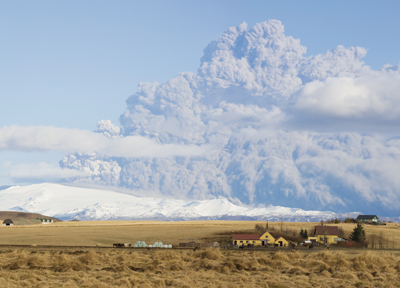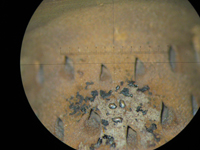
Features
Safety
The Volcanic Disruption
The April 2010 Eyjafjallajökull volcanic eruption brought European and North Atlantic air traffic to a halt. Billions of dollars were lost by the airline industry, and millions of travellers were stranded.
May 17, 2010 By James Careless
The April 2010 Eyjafjallajökull volcanic eruption brought European and North Atlantic air traffic to a halt. Billions of dollars were lost by the airline industry, and millions of travellers were stranded.

|
|
| PHOTO: iStock (IcerOck)
|
Following a two-week lull, new eruptions in early May continued to threaten the skies of Britain and Ireland. In light of this wide-spread natural disaster, it’s time to consider four lessons from this exceptional experience.
Lesson 1: Somehow, We Need to Agree on Scientifically Sound Standards
As aviation hazards go, volcanic eruptions are a rarity. Eruptions whose ash clouds pose a danger to heavily travelled air routes are even rarer. That’s why European officials really didn’t know how to deal with the Eyjafjallajökull ash cloud, beyond grounding all air traffic.
Wings contacted major airlines and aircraft manufacturers for their comments on this decision. The only response we received was from Boeing. Speaking on background, a source with the company said, “The best way to deal with volcanic ash is for airplanes to avoid it. [Unfortunately] while obvious ash plumes are avoidable, not all ash can be picked up by radar and can damage engines, paint, ventilation and electronic systems.”
In agreeing with Boeing and grounding all planes, European air authorities were applying a “black and white rule,” said IATA North America spokesman Steve Lott. “Their stance was that if there’s any ash at all, you shouldn’t fly,” he said. “But we would argue that there are shades of grey when it comes to volcanic ash concentrations. That’s a point the U.K. Civil Aviation Authority (CAA) eventually grasped, when they defined no-fly, buffer and open flying areas around the ash cloud.”
“We achieved what often takes years in 96 hours,” boasted U.K. CAA Chief Executive Andrew Haines, in justifying the CAA’s speedy determination of safe ash levels for aviation. “We undertook much of this research and led the international discussions and investigation which brought manufacturers to agree on an accurate and evidence-based set of restrictions and agree on engine tolerance levels to ash density.”
Really? Robert Kokonis, president of airline consulting firm AirTrav Inc., doesn’t think so. “I don’t normally side with pilots’ unions – I’ve negotiated against them for the airlines – but I must agree with the union spokespersons that there is a lack of rigorous testing in this area,” he told Wings. “It just isn’t good enough for British Airways, KLM and Lufthansa to send a few aircraft through the ash cloud, land and have a chat with Pratt & Whitney, Rolls-Royce and GE, and then say, ‘we’ve got a new Standard Operating Procedure!’”
To put this risk into perspective: Currently about 28,000 aircraft fly through Euro-controlled airspace and 1,200 more use the North Atlantic Track on a daily basis, Kokonis said. “Even if only 0.1 per cent of these flights ran into trouble due to the Eyjafjallajökull ash cloud, you still would have been talking about 30 flights. Assuming 150 people per flight, that would have been 4,500 people put at risk daily. That’s just not an acceptable number.”

|
|
| After flying through the ash cloud, the Finnish Air Force noted varying amounts of damage to critical components. PHOTO: Finnish Air Force
|
Clearly, realistic, scientifically sound volcanic ash flight thresholds are needed. The problem is that this requires research that takes considerably longer than 96 hours from start to finish. Moreover, “to get accurate data on ash levels, you have to deliberately fly into the ash clouds,” said Dr. Michael Fabian of Embry-Riddle Aeronautical University in Prescott, Ariz. “I would not recommend ‘ash damage testing’ in the air. That is a job for engine test cells on the ground. A few tried it in flight to prove a point but they don’t know the internal damage in the internal cooling channels yet.”
Worth noting: “AirBus has the equipment necessary to put an engine in a test chamber, run it up to operational speeds and then bombard it with varying concentrations of volcanic ash,” noted Dr. Fred Prata. He works at the Norwegian Institute for Air Research (NILU) in Kjeller, Norway. “The problem is, who will pay for this research, which could run into the millions?”
Lesson #2: Airlines Must Get More Involved in Volcanic Ash Research
Dr. Prata and his atmospheric science colleagues actively research volcanic ash, and then share their results and ideas at conferences. “But you almost never see any airline people attending,” he said. “Qantas has been extremely good about taking part, and we’ve seen British Airways, Japan Airlines, Lufthansa and either Delta or United attend occasionally, but that’s it. You’d think they’d all want to be involved, given the impact volcanic ash can have on their business.”
Too true: perhaps this will change in the wake of the Eyjafjallajökull ash cloud. Logically, the loss of billions of dollars should convince airlines to get more involved in volcanic ash research.
Lesson #3: Europe Needs One Air Traffic Control System
“We don’t dispute the fact that ash clouds can cause serious damage to aircraft engines,” said IATA spokesman Steve Lott. “But why did we have to wait five days before Europe’s transportation ministers got together and discussed the airspace closure?” The answer is that European countries still control their national airspaces independently, without a single central authority co-ordinating it as a whole. “That’s got to change: We need some kind of central authority that can make these decisions quickly and deal with situations quickly,” Lott said.
Ironically, European countries have been working towards an integrated ATC solution known as the “Single European Sky” (SES) initiative, but they haven’t finalized it yet. Had SES been in place when the Eyjafjallajökull eruption occurred, the situation would likely have been handled in a timelier and far less confused fashion.
Lesson #4: It’s Time for an Airborne Solution
Developing acceptable volcanic ash thresholds for engines isn’t enough, nor are software programs that predict ash concentration. The reason is that volcanoes don’t emit ash on any sort of consistent, predictable basis. A volcanic “plume” cloud can have varying densities of ash in any given location. This is why aircraft venturing into volcanic ash need some kind of on-board ash detectors.
Dr. Fred Prata has developed such a detector; in fact, he has six prototypes already built. The device measures infrared light in an aircraft’s flight path. “Since the glass and rock particles that comprise volcanic ash absorb infrared light, their presence and density can be detected and avoided in real time,” he told Wings. “The ash detector was first developed in the early 1990s and has been field-tested over a number of active volcanoes, but has sat on the shelf due to lack of investor interest.” Dr. Prata estimates that a commercially certified ash detector could cost about $100,000.
The Devil Is in the Details
The chaos caused by the Eyjafjallajökull ash cloud has revealed a serious vulnerability in the aviation industry. It has also highlighted the clear need for safe volcanic ash thresholds.
As for a solution? That’s going to require lots of research, money and air carrier involvement: the kind of details that cash-strapped companies don’t want to deal with. Unfortunately, unless this changes, the vulnerability remains. Should a future eruption similarly cut into busy airspace and last longer, the results will be financially apocalyptic for the aviation industry.